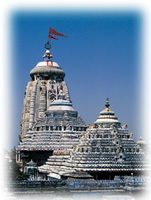 |
 |
Jagannatha
Temple* Puri, Orissa |
Ratha
Yatra procession New York City |
A story is told that thousands of years ago a king named Indradyumna wanted to build a temple to honour the god Krishna, his brother Balarama and his sister Subhadra. He sought the help of the artisan Visvakarma, who agreed to carve the images as long as his work was never disturbed. The king agreed, however curiosity got the better of him; when he entered the room to check on Visvakarma’s progress the artisan vanished, leaving behind three incomplete forms. Nonetheless Indradyumna was so pleased he installed the statues in a temple, and each year he arranged a procession in which the three gods were paraded through the realm in beautifully decorated carts.
Ratha Yatra (‘chariot festival’) originated in Puri in Orissa on the North Eastern coast of India where it is still observed. The main event is the enthronement of the temple deities on chariots designed to resemble the tower of the Jagannatha temple. New chariots are built every year, but the images are renewed every twelve years: carved from the trunk of the neem, a hard wood tree with medicinal value, they are deliberately left unfinished in honour of their origin.
It is during the procession, that Krishna presents himself as Jagannatha,** the Lord of the Universe. Around 500 years ago, a Krishna devotee and sannyasin, Nimai Pandit, settled in Puri. Each year he danced and chanted in the procession, and his followers came to believe that he was an incarnation of Krishna himself. Known as Lord Caitanya, he established the Maha-Mantra—‘great mantra’—a practice involving the chanting of the holy names of Krishna:
Hare
Krishna, Hare Krishna, Krishna Krishna, Hare Hare
Hare Rama, Hare Rama, Rama Rama, Hare Hare.
To this day, followers of Lord Caitanya participate in the Ratha Yatra in Puri and elsewhere throughout India and the world, believing that anyone who sees Lord Jagannatha or pulls his chariots will achieve immense spiritual benefit.
**The temple and the large chariots of the festival is where the English word for a huge lorry derives, i.e. juggernaut.